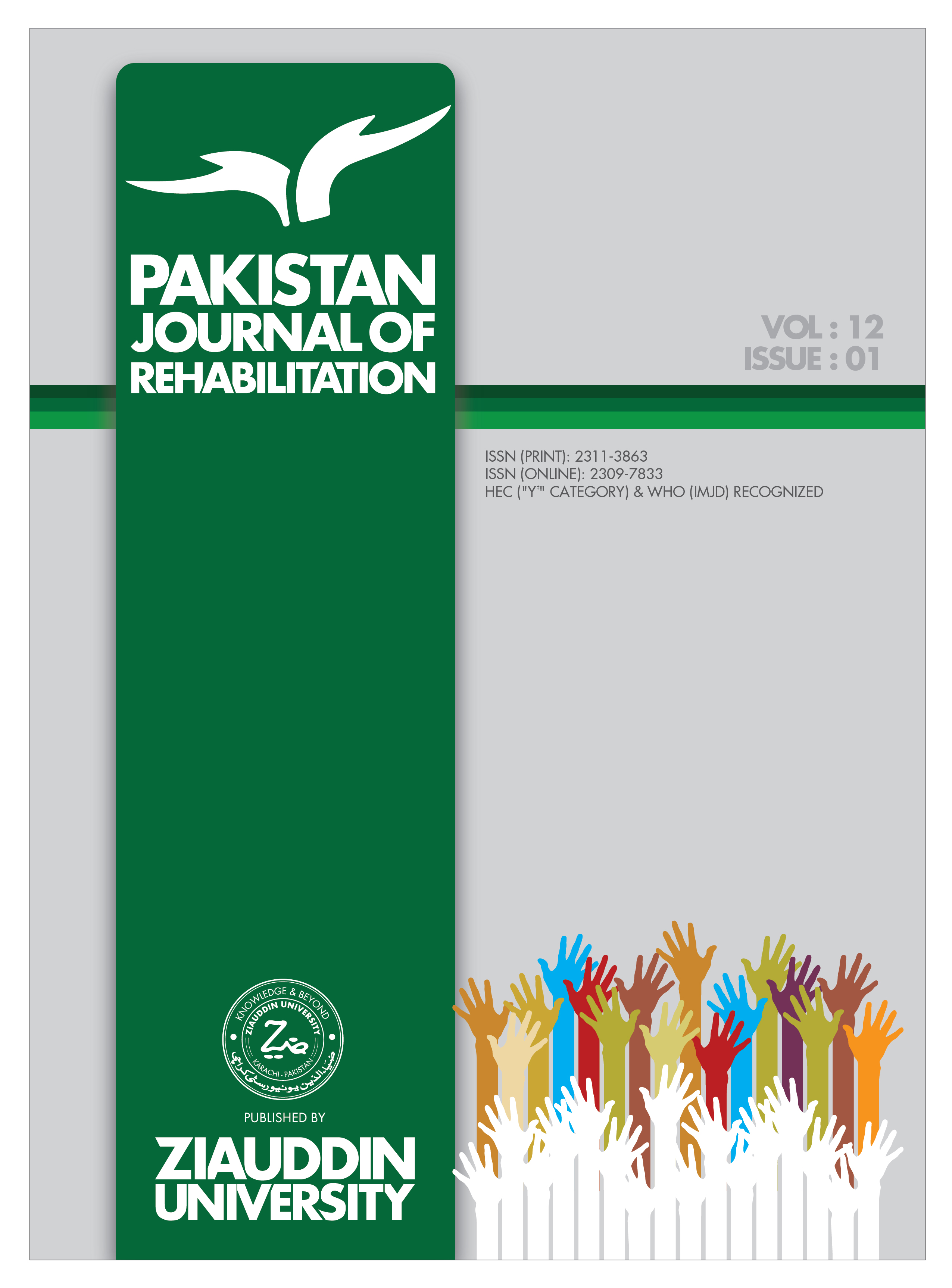EFFECTS OF MILD, MODERATE AND INTENSE PHYSICAL ACTIVITY ON KNEE JOINT PROPRIOCEPTION IN HEALTHY YOUNG ADULTS
Keywords:
Continuous passive, kinesthesia, exercise movement techniques, motion therapy, position sense, proprioceptionAbstract
Aim: To evaluate the immediate effects of various activity levels on knee joint position sense.
Methodology: Sixty males aged between 19 and 24 years, without any complains of discomfort or pain in the knee joint were selected from Bakhtawar Amin Hospital, Multan using convenience sampling, between April 2nd, 2019 to July 28th, 2019. Group A participants walked on the treadmill at a speed of 4 km/h for 5 min (n = 20). Group B participants ran on a treadmill at 6.4 km per hour for five minutes (n = 20). Group C participants sprinted on a treadmill at 8.5 km per hour for five minutes (n = 20).
Results: Mean age of the subjects was 21.18±1.77. In the moderate physical activity group, the difference in the means in passive reproduction of the knee flexion angle of 20o observed was 1.40±2.39, (p-value 0.013), and similarly in intense physical activity was 1.75±3.58 (p-value 0.020). For the knee flexion angle of 40o, the difference in the means for moderate was 1.35±1.84 (p=0.002), and for the intense activity was 2.35±2.27 (p=0.012). However, in the group with mild physical activity, the difference in the means was statistically insignificant.
Conclusion: The study indicated that physical activities of moderate level and intense level decrease the joint position sense appreciation at the knee joint in less active healthy individuals.
References
Teyhen DS, Rhon DI, Butler RJ, Shaffer SW, Goffar SL, McMillian DJ, et al. Association of physical inactivity, weight, smoking, and prior injury on physical performance in a military setting. Journal of athletic training. 2016;51(11):866-75.
Loprinzi PD, Kane CJ, editors. Exercise and cognitive function: a randomized controlled trial examining acute exercise and free-living physical activity and sedentary effects. Mayo Clinic Proceedings; 2015: Elsevier.
Fox AJ, Wanivenhaus F, Burge AJ, Warren RF, Rodeo SA. The human meniscus: a review of anatomy, function, injury, and advances in treatment. Clinical Anatomy. 2015;28(2):269-87.
Han J, Anson J, Waddington G, Adams R, Liu Y. The role of ankle proprioception for balance control in relation to sports performance and injury. BioMed research international. 2015;2015.
Hewett TE, Myer GD, Kiefer AW, Ford KR. Longitudinal increases in knee abduction moments in females during adolescent growth. Medicine and science in sports and exercise. 2015;47(12):2579.
Gong C, Liu W. Acupuncture in Orthopedics. International Journal of Clinical Acupuncture. 2015;24(1).
Alhajaya M. Effects of proprioception training on knee joint position sense in male soccer athletes. J Sociol Res. 2015;6.
Soligard T, Schwellnus M, Alonso J-M, Bahr R, Clarsen B, Dijkstra HP, et al. How much is too much?(Part 1) International Olympic Committee consensus statement on load in sport and risk of injury. British journal of sports medicine. 2016;50(17):1030-41.
Huang D, He X-Z, Yang X-H, Peng S-M, Wu Y-X. Stratification of injuries to the lateral collateral ligament of the ankle using ultrasound: protocol of a prospective, open-label, diagnostic trial and preliminary results. Clinical Trials in Orthopedic Disorders. 2018;3(2):53.
BALBA AE-DA, ALAA IE-K, AHMED H, MOHAMMED MM. Effect of Core Stability Training on Knee Proprioception after Anterior Cruciate Ligament Reconstruction. The Medical Journal of Cairo University. 2018;86(March):231-40.
Kavita K, Hassan NC. Work stress among teachers: A comparison between primary and secondary school teachers. International Journal of Academic Research in Progressive Education and Development. 2018;7(4):60-6.
Han J, Waddington G, Adams R, Anson J, Liu Y. Assessing proprioception: a critical review of methods. Journal of Sport and Health Science. 2016;5(1):80-90.
Robinson M, Siddall A, Bilzon J, Thompson D, Greeves J, Izard R, et al. Low fitness, low body mass and prior injury predict injury risk during military recruit training: a prospective cohort study in the British Army. BMJ open sport & exercise medicine. 2016;2(1):e000100.
Tricco AC, Antony J, Zarin W, Strifler L, Ghassemi M, Ivory J, et al. A scoping review of rapid review methods. BMC medicine. 2015;13(1):224.
Kollock R, Van Lunen BL, Ringleb SI, Oñate JA. Measures of functional performance and their association with hip and thigh strength. Journal of athletic training. 2015;50(1):14-22.
Barber-Westin SD, Noyes FR. Effect of fatigue protocols on lower limb neuromuscular function and implications for anterior cruciate ligament injury prevention training: a systematic review. The American journal of sports medicine. 2017;45(14):3388-96.
Shultz SJ, Schmitz RJ, Benjaminse A, Collins M, Ford K, Kulas AS. ACL Research Retreat VII: an update on anterior cruciate ligament injury risk factor identification, screening, and prevention: March 19–21, 2015; Greensboro, NC. Journal of athletic training. 2015;50(10):1076-93.
O’Connor KM, Johnson C, Benson LC. The effect of isolated hamstrings fatigue on landing and cutting mechanics. Journal of applied biomechanics. 2015;31(4):211-20.
Jo Y-J, Kim Y-K. Different types of shoulder injuries of throwing and resistance training groups. The Official Journal of the Korean Academy of Kinesiology. 2016;18(3):73-83.
Wilson LM, Greig M. The efficacy of functional supports in mediating the effects of exercise on shoulder joint position sense. Isokinetics and Exercise Science. 2017;25(2):127-34.
Bossuyt FM, García-Pinillos F, Azidin RR, Vanrenterghem J, Robinson MA. The utility of a high-intensity exercise protocol to prospectively assess acl injury risk. International journal of sports medicine. 2016;37(02):125-33.
Daly AC, Critchley SE, Rencsok EM, Kelly DJ. A comparison of different bioinks for 3D bioprinting of fibrocartilage and hyaline cartilage. Biofabrication. 2016;8(4):045002.
Alhajaya M. Effects of proprioception training on knee joint position sense in male soccer athletes. J Sociol Res. 2015;6.
Salgado E, Ribeiro F, Oliveira J. Joint-position sense is altered by football pre-participation warm-up exercise and match induced fatigue. The Knee. 2015;22(3):243-8.
Relph N, Herrington L. The effects of knee direction, physical activity and age on knee joint position sense. The Knee. 2016;23(3):393-8.
Romero-Franco N, Jiménez-Reyes P. Effects of warm-up and fatigue on knee joint position sense and jump performance. Journal of motor behavior. 2017;49(2):117.

Downloads
Published
How to Cite
Issue
Section
License
Copyright (c) 2022 Pakistan Journal of Rehabilitation

This work is licensed under a Creative Commons Attribution 4.0 International License.



